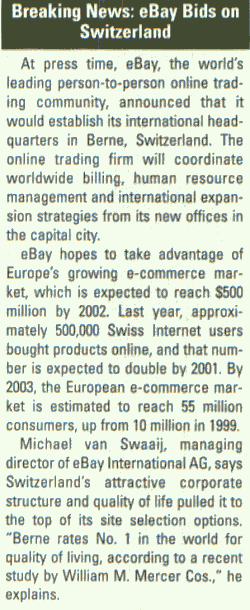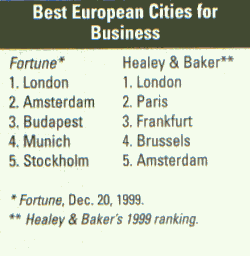A good man is hard to find, especially in a market where unemployment rates have dropped nearly a full percentage point from last year and continue to drop by approximately one-tenth a month. For this reason, many site seekers are looking away from Europe’s usual suspects for more abundant labor pools.
Although the European labor market isn’t quite as tight as the United States (4 percent unemployment) or Japan (4.6 percent), it’s definitely on its way. The Eurostat Press Office (http://europa.eu.int/comm/eurostat/) reports that the European Union (EU)-15’s unemployment rates dropped from 8.4 percent in June to 8.3 percent in July. Even more dramatic is the year-to-year comparison in which the EU15 had an unemployment rate of 9.1 percent last July, compared with the current 8.3 percent. Some of the tightest markets are Luxembourg, which came in with a 2.2 percent unemployment rate in July, followed by the Netherlands’ 2.6 percent. Austria had the second-highest unemployment rate in the union with 3.2 percent.
“The availability of labor is becoming more and more important,” says Wim Douw, a consultant with PricewaterhouseCoopers-Plant Location International (PWC-PLI at www.pwcglobal.com) in Brussels. “We see companies, especially large manufacturers, scaling back operations recently due to the tightness in labor markets. As a result, they’re looking at alternative locations and are at least considering in the initial [site selection] stages co-location opportunities.”
Labor Pool Alternatives
One strategy for tackling the labor problems is locating to markets with more abundant labor pools. Douw cites Dublin, the Netherlands, the UK and Stockholm, Sweden, as locations with labor markets tightening to the point that companies are looking for alternatives.

“Stockholm, which is probably the size of Silicon Valley and the No. 1 IT location worldwide, is really experiencing some tightness in the IT skills,” he explains. “Ericsson, for example, decided not too long ago to expand a new software development center in Canada rather than in Stockholm.”
The labor market tightness also helps explain the recent eastern movement of corporations in Europe. Although Eastern Europe’s low costs are the primary draw, labor availability is another, reports Douw. Prague, Czech Republic, for instance, had a 9.7 percent unemployment rate as of February, according to New York-based Cushman & Wakefield, a real estate service provider (www.cushwake.com).
For those not wanting to head east to find labor, alternative markets in Western Europe are emerging as well, especially in second-tier cities. One key example of this movement can be seen in shared service facilities. In the past, 90 percent of pan-European shared service centers set up shop in four primary locations: Dublin, Ireland; Amsterdam and Rotterdam, the Netherlands; and London.
“Those were the first markets that experienced the tightness,” Douw explains. “So shared service centers began to look at other locations within those three countries. One of the hot spots in the Netherlands at the moment is Maastricht. It’s not a huge market, but it’s located on the Belgium and German borders, so it has lots of languages. A lot of companies recognized those advantages and have set up their operations there.”
Barcelona is another hot spot for pan-European shared service centers. General Motors, for instance, recently set up a 600-person operation there, and Avis, a car rental company, opened a 170-person reservation center for Southern Europe. “Barcelona is a very international environment with a nice living climate, and it’s an attractive city for people to locate,” Douw says. “It’s still very low cost, and the overall business development has improved over the past 10 years. It’s a good location for support locations, and it will certainly succeed with companies that are trying to avoid the labor tightness.”
Barcelona, in fact, had the highest unemployment rate within the Euro-zone in July at 14.2 percent. And according to Eurostat, that labor pool is quite a young one. The “under-25s” unemployment rate in Spain was greater than 25 percent.
Labor hungry companies are also changing their facility location strategies to cope with Europe’s labor markets, says Douw. To avoid having all their employees in one pan-European center, “they’re setting up a couple of centers based on regional and language markets,” he continues. “So they may set up one center to focus on the Southern Europe languages, one focusing on Nordic and Scandinavian languages, and maybe one for the German and Eastern European languages. We’ve seen several examples of that, and that will set the trend for the next couple of years.”
Large Markets Continue to Thrive
Despite their dwindling labor pools, the major European markets are still atop the list of business locations (see chart). The UK and Ireland continue to attract some 40 percent to 50 percent of US investment, and Japanese investors, though their numbers are much less today than 15 years ago, strategically place locations in the major markets of the UK, Germany and France.
Specifically speaking the US companies typically go to the major metros of Dublin, London, Ile-de-France (Greater Paris) and Amsterdam. In fact, “one in five US investments goes into the Greater London area,” says Roel Spee, director with PWC-PLI. And in the past, Japanese firms located most of their European headquarters in Germany’s Dusseldorf and Frankfort markets.

Language familiarities and historical ties make the UK and Ireland much more comfortable locations for US investors. Japanese firms, on the other hand, thought locating in major markets throughout Europe was a much more strategic plan for reaching the entire continent.
European companies, however, already have a strong presence on the continent, and so they have lead the way in the move toward Eastern Europe. “Eastern Europe is the logical next step to grow their business,” Spee says. “And European firms are more familiar with Eastern Europe as a new environment to set up operations. Lots of German companies when the Wall came down immediately moved to the Czech Republic because it is a fairly small step for them, but a huge difference costwise.”
The Eastern European countries receiving the most attention are Poland, Hungary and the Czech Republic. Within those countries, the hot spots there, like most emerging economies, are the capital cities: Warsaw, Budapest and Prague. Spee also adds the southern Poland city of Katowice as a hot market, especially for automotive manufacturing.
“General Motors set up a car manufacturing plant in that area a couple of years ago, and as we’ve seen in recent years in the automotive industry, a lot of suppliers have followed the major car manufacturers,” he explains.
The Cluster Effect
Although most of Europe’s major metropolitan markets continue to attract a wide array of industries, such industry clusters as that in Katowice are becoming more pronounced throughout the continent.
Electronics, for example, have found a home in the Eastern European countries. Spee cites such names as Flextronics, Philips and IBM as firms with manufacturing operations in the Budapest area.
“The Czech Republic and Hungary has a lot of expertise with mechanical operations, mechanical engineering, the more electronics-oriented, so those industries looking for those types of skills are locating in those areas,” says Spee. “The whole region between the capital city of Budapest and Vienna, Austria, has seen a real zone develop in the last couple of years that has attracted a lot of electronic companies.”
The pharmaceuticals industry, which typically has high profit margins, has found Ireland a particularly nice spot for operation due to the low tax rates. So much so that even though many pharmaceutical companies have merged and consolidated operations throughout Europe, “they continue to expand in Ireland,” Douw explains. American Home Products Corp. recently announced a US$758 million investment in Dublin, creating 1,300 jobs.
Chemical firms, much like the automotive companies, are bringing with them large numbers of supply companies to port locations like Rotterdam, the Netherlands; Antwerp, Belgium; and Le Havre, France. The chemical clusters, however, are going one step further by actually co-locating facilities. “They’re literally setting up on the same sites to use the same infrastructure, same pipelines, same roads, same railways, same security services and so forth,” says Douw. “By doing that they will reduce their costs dramatically, and because they very often use the same raw materials, they’ll benefit from locating near the ports.”
Perhaps the strongest industry cluster can be found in the software/IT/E-commerce industries. “Stockholm is the No. 1 region for those industries,” says Douw. “Scandinavia in general is very strong — Stockholm and Helsinki, Finland. Obviously it has a lot to do with the large companies already there — Ericsson and Nokia, for example. But people in those areas are eager to learn and pick up every new technology development there is. That is an industry segment that will continue to cluster because the skills needed are developed at the large, major universities and where companies set up new R&D environments. So that trend will continue.”